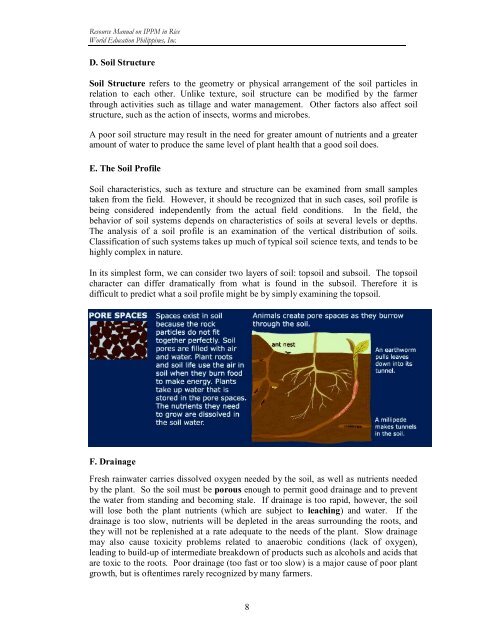(IPPM) in Vegetables - Vegetableipmasia.org
(IPPM) in Vegetables - Vegetableipmasia.org
(IPPM) in Vegetables - Vegetableipmasia.org
Create successful ePaper yourself
Turn your PDF publications into a flip-book with our unique Google optimized e-Paper software.
Resource Manual on <strong>IPPM</strong> <strong>in</strong> Rice<br />
World Education Philipp<strong>in</strong>es, Inc.<br />
D. Soil Structure<br />
Soil Structure refers to the geometry or physical arrangement of the soil particles <strong>in</strong><br />
relation to each other. Unlike texture, soil structure can be modified by the farmer<br />
through activities such as tillage and water management. Other factors also affect soil<br />
structure, such as the action of <strong>in</strong>sects, worms and microbes.<br />
A poor soil structure may result <strong>in</strong> the need for greater amount of nutrients and a greater<br />
amount of water to produce the same level of plant health that a good soil does.<br />
E. The Soil Profile<br />
Soil characteristics, such as texture and structure can be exam<strong>in</strong>ed from small samples<br />
taken from the field. However, it should be recognized that <strong>in</strong> such cases, soil profile is<br />
be<strong>in</strong>g considered <strong>in</strong>dependently from the actual field conditions. In the field, the<br />
behavior of soil systems depends on characteristics of soils at several levels or depths.<br />
The analysis of a soil profile is an exam<strong>in</strong>ation of the vertical distribution of soils.<br />
Classification of such systems takes up much of typical soil science texts, and tends to be<br />
highly complex <strong>in</strong> nature.<br />
In its simplest form, we can consider two layers of soil: topsoil and subsoil. The topsoil<br />
character can differ dramatically from what is found <strong>in</strong> the subsoil. Therefore it is<br />
difficult to predict what a soil profile might be by simply exam<strong>in</strong><strong>in</strong>g the topsoil.<br />
F. Dra<strong>in</strong>age<br />
Fresh ra<strong>in</strong>water carries dissolved oxygen needed by the soil, as well as nutrients needed<br />
by the plant. So the soil must be porous enough to permit good dra<strong>in</strong>age and to prevent<br />
the water from stand<strong>in</strong>g and becom<strong>in</strong>g stale. If dra<strong>in</strong>age is too rapid, however, the soil<br />
will lose both the plant nutrients (which are subject to leach<strong>in</strong>g) and water. If the<br />
dra<strong>in</strong>age is too slow, nutrients will be depleted <strong>in</strong> the areas surround<strong>in</strong>g the roots, and<br />
they will not be replenished at a rate adequate to the needs of the plant. Slow dra<strong>in</strong>age<br />
may also cause toxicity problems related to anaerobic conditions (lack of oxygen),<br />
lead<strong>in</strong>g to build-up of <strong>in</strong>termediate breakdown of products such as alcohols and acids that<br />
are toxic to the roots. Poor dra<strong>in</strong>age (too fast or too slow) is a major cause of poor plant<br />
growth, but is oftentimes rarely recognized by many farmers.<br />
8




![Section 4 [ PDF file, 252 KB] - The Field Alliance](https://img.yumpu.com/51387260/1/158x260/section-4-pdf-file-252-kb-the-field-alliance.jpg?quality=85)












